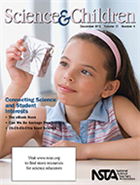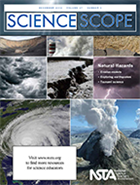NSTA's K-12 Science Education Journals: December Issues Online
By Lauren Jonas, NSTA Assistant Executive Director
Posted on 2013-12-03
The holidays are upon us, but you don’t get a break from teaching quite yet. You need science education resources that you can use in your classroom tomorrow, and the National Science Teachers Association (NSTA) has them for you! Written by educators, these grade-level journals are targeted to your teaching level. NSTA’s December journals are live online (with select articles being free for all, and full content being free to all NSTA members). Browse these issues for classroom-tested ideas, activities you can use tomorrow, and commentary from experts in the field.
 Science and Children
Science and Children
To help students build their own conceptual understanding, it is important to engage them in learning in a way that translates the core ideas into understandable experiences. This issue offers resources and strategies for tapping into students’ interests to stimulate engaging science instruction.
Featured articles (please note, only those marked “free” are available to nonmembers):
- Can We Be Garbage Free?
- Ch-Ch-Ch-Chia Seed Science
- Free – Editor’s Note: Student Interests: Tapping Into Passion
- Exploring the Wild World of Wiggly Worms!
- Making Connections Between the Digital and Physical World
- Free – The eBook Hook
- Full Table of Contents
 Science Scope
Science Scope
Our Earth is covered with impact craters, fault lines, and storm damage from natural hazards that have plagued our planet in the past. Learn more about the fascinating forces of nature with the activities found in this issue of Science Scope so you can better understand the next disaster that comes our way.
Featured articles (please note, only those marked “free” are available to nonmembers):
- 99.99%—Antibacterial Products and Natural Selection
- Free – Authentic Landscapes Indoors: Using Erosion Models to Connect Science and Engineering Practices
- Bringing Earthquake Engineering to Your Hometown
- Cookie Tectonics: An Introduction to Earth Hazards and Tectonic Fundamentals
- Free – Editor’s Roundtable: Could You Live Here?
- Exploring Earthquakes and Tsunamis: Integrating Science, Social Studies, and Technology
- Simulating Earthquake Early Warning Systems in the Classroom
- Special Education in the Science Classroom: A Co-Teaching Scenario
- Using Web GIS to Enhance Tectonics Learning and Geospatial Thinking
- Full Table of Contents
 The Science Teacher
The Science Teacher
This issue of The Science Teacher focuses on one of the seven crosscutting concepts—”patterns”—found in the Next Generation Science Standards (NGSS). Crosscutting concepts have been prominent in education reform documents for over two decades. What’s new is that the NGSS elevates crosscutting concepts by weaving them into the student performance expectations for all students, so that they will become an explicit part of science instruction beginning in the earliest years of schooling. This issue presents several articles that will help you bring the crosscutting concept of Patterns into your classroom, including a history of science piece on the classification of species—a practical and important application of pattern recognition.
Featured articles (please note, only those marked “free” are available to nonmembers):
- Free – Career of the Month: An Interview With Ecosystem Scientist Stan Wullschleger
- Classification
- Free – Editor’s Corner: Crosscutting Patterns
- Science Challenge Day
- Science Immersion
- What Makes Us Tick…Tock?
- Free – Where’s That Dolphin?
- Full Table of Contents
Disclaimer: The views expressed in this blog post are those of the author(s) and do not necessarily reflect the official position of the National Science Teaching Association (NSTA).

